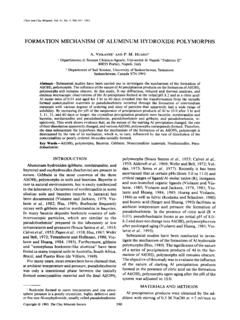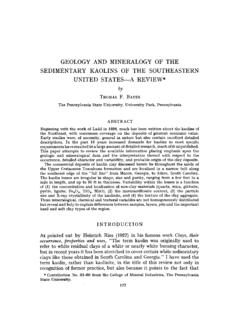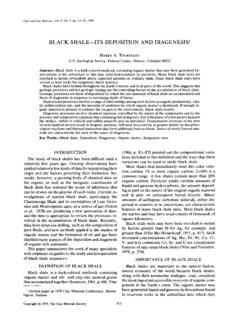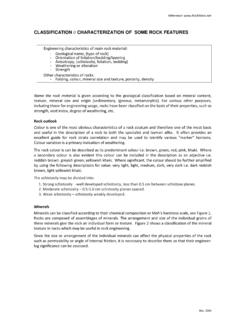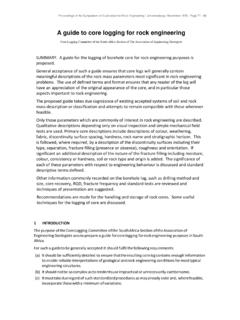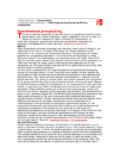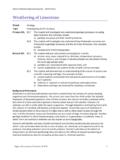Transcription of WEATHERING OF BASALT: CHANGES IN ROCK …
1 Clays and Clay Minerals, Vol. 35, No. 3. 161-169, 1987. WEATHERING OF BASALT: CHANGES IN ROCK CHEMISTRY AND MINERALOGY RICHARD A. EGGLETON, CHRIS FOUDOULIS, AND DANE VARKEVISSER Department of Geology, Australian National University Canberra, ACT 2601 Australia Abstract--The WEATHERING of eastern Australian basalts, sampled from the rounded, hard, core-stone to the rind of softer weathered material, has been examined by bulk chemical analyses, thin section pe- trography, electron microprobe, and X-ray powder diffraction analyses. Using density as a measure of WEATHERING intensity, data from four core-stones show that at a stage of WEATHERING in which the total loss due to dissolution is I/3 ( , at the core-stone rim), the percentages lost of the following major elements are: Ca, 85; Mg, 80; Na, 70; K, 50-80; P, 55; Si, 45; Mn, 40; A1, 5; Fe, 0; and Ti, 0.
2 With more intense WEATHERING , deposition of some elements, particularly rare earths and Ba, and mobilization and deposition of A1 and Fe make quantification impossible. The rate of WEATHERING of individual minerals is consistent with the well-known susceptibility series: glass ~ olivine > plagioclase > pyroxene > opaque minerals. Clay minerals in the core-stones are dominated by smectites, whereas those in the surrounding more intensely weathered rinds are dominated by halloysite and goethite. Key Words--Basalt, Core-stone, Element mobilization, Goethite, Halloysite, Smectite, WEATHERING . INTRODUCTION The investigations described in this and succeeding papers of this series were conducted to understand the mechanism of basalt WEATHERING by examining the pro- cess at the maximum available resolution. Optical mi- croscopic, X-ray powder diffraction, transmission and scanning electron microscopic, bulk chemical, energy- dispersive X-ray, electron microprobe, and various other analytical techniques were used to trace mineral alterations and to evaluate these alterations within a broader framework of the bulk CHANGES occurring in the whole rock during the WEATHERING process.
3 The present paper describes the larger scale aspects of the WEATHERING of several southeastern Australian basalts on samples taken from the fresh, rounded, core- stone out to the edge of the surrounding coherent WEATHERING rinds and discusses the CHANGES in bulk- rock chemistry and mineralogy that accompanied this early WEATHERING . Later papers will present detailed ex- aminations of the alteration of individual minerals, including the WEATHERING of olivine to iddingsite and bowlingite and the WEATHERING of plagioclase, pyroxene, and opaque oxides. BACKGROUND Rock WEATHERING begins when WEATHERING agents first react chemically with the minerals of the rock; how- ever, many WEATHERING studies pass over these initial reactions and concentrate on the formation of sapro- lites and soils. The minerals in a saprolite that ulti- mately transform to produce the constituents found in the overlying soil are themselves alteration products of the initial WEATHERING of the minerals of the parent rock.
4 As a prelude to understanding the formation of Copyright 9 1987, The Clay Minerals Society saprolite zones and soil horizons formed from them, it is vital to understand first the chemical and miner- alogical CHANGES that attend these early WEATHERING re- actions. Many of the earlier studies of basalt WEATHERING have been summarized by Loughnan (1969). Volcanic glass is the most susceptible component of such rocks ; it alters to palagonite. Almost as susceptible is olivine, which may alter to saponite or nontronite (Craig and Loughnan, 1964), or, after loss of magnesia and oxi- dation of iron, to hematite, maghemite, or goethite. Basalts in New South Wales studied by Craig and Loughnan (1964) show the mineral susceptibility se- quence olivine > pyroxene> plagioclase > sanidine. The ferromagnesian minerals form pseudomorphs of trioctahedral smectite, whereas plagioclase alters to pseudomorphous dioctahedral smectite.
5 Alkali feld- spar alters to kaolinite or halloysite. Colman's (1982) study of the chemical WEATHERING of basalt and andesite core-stones synthesized the broad chemical reactions and mineralogical transformations that take place in early basalt WEATHERING . He found the susceptibility of various minerals to WEATHERING increases generally in the sequence: glass > olivine > pyroxene > amphibole > plagioclase > K-feldspar, but with some variability. Ultimately, all these min- erals alter to a mixture of allophane, iron oxide-hy- droxide, and clay minerals. Colman also described var- ious stages in the alteration of the basalt and andesite minerals, classifying each product on the basis of its optical appearance, qualitative electron probe analysis, and some X-ray powder diffraction observations. Many of the alteration minerals were described in only rather imprecise terms ( , 'iddingsite', chlorophaeite, al- 161 162 Eggleton, Foudoulis, and Varkevisser Clays and Clay Minerals (9 (D I loss <average a " ;'average I I 0 1 2 3 b density (g/ml) early resistant mineral nif loss ~ e (9 E (9 I early soluble mineral 0 1 2 3 density (g/ml) Figure 1.)))))
6 Element or oxide loss in mass/unit volume related to density. (a) General trends shown by an element present in most minerals of the rock ( , Si). An element whose loss rate is less than the average (=total) loss rate gives a lower gradient than one whose loss rate is average. (b) Trends shown by an element dominantly in one mineral ( , Na, found only in plagioclase). A resistant mineral will give rise to a lower gradient at the start of WEATHERING , which steepens as other more mobile elements are lost. lophane, iron oxide-hydroxide), but Colman's descrip- tions provide a valuable basis for further study. Colman (1982) pointed out several ways of relating chemical movement during WEATHERING , including WEATHERING indexes, standard cell calculations, ratio of elements to an immobile element, and calculations based on constant volume using density measurements (isovolumetric).
7 Density (or specific gravity) gives a measure of the total loss through leaching, provided that no deposition has occurred from outside the core- stone, and neither expansion nor contraction of the rock has taken place. Density is used throughout the present study to convert bulk-rock elemental weight percentages to g/cm 3 of rock, except for a few samples in which specimen incoherence prevented a density measurement. Colman (1982) speculated that a vol- ume loss may accompany rind formation, despite the fact that he reported no thin section evidence for such a loss, because Ti and other less mobile elements in- creased in concentration, if no volume loss was as- sumed. On the basis of constant Ti, he calculated a volume loss of 40-50%, consistent with the very large decreases in density reported by Hendricks and Whittig (1968) for andesite WEATHERING .
8 In a broad sense, WEATHERING intensity increases smoothly from the center of a core-stone outward, but this progression may be interrupted locally by in- creased WEATHERING on either side of cracks. Density, therefore, provides a more reliable estimate of weath- ering intensity than distance from a core-stone center or profile depth. Accordingly, density has been used as the ordinate to compare elemental mobility during WEATHERING . Graphs of each element's mass/unit vol- ume vs. whole rock density through a WEATHERING pro- file can be thought of as showing single element density vs. total element density and thereby allows a quan- titative comparison of element loss to be made (Figure 1). Colman (1982) concluded that for his data elemental gains and losses were best referenced to TiO2 as an assumed immobile element, an assumption shared by many previous workers.
9 For a few friable samples in the present study, on which density could not be mea- sured, densities were calculated assuming immobile Zr, Ti, and Nb if these three elements correlated closely on a weight percentage basis. ANALYTICAL METHODS Bulk chemical analyses of various basalt core-stones and rinds were made for all components except Na, H20, CO2, and Fe(II) by X-ray fluorescence analysis (Norrish and Chappell, 1977). Sodium was determined by flame photometry, H20 by absorption on P205, and CO, by absorption on NaOH. Elemental analyses of minerals were made by energy-dispersive electron mi- croprobe (N. Ware, analyst) on moderately to well- polished mineral grains. Density was measured by water displacement using a top-loading balance. Absorbant samples (almost all) were coated with paraffin wax after weighing in air, and the volume measured by water displacement was corrected by subtraction of the par- affin wax volume estimated by weight.
10 Clay minerals were identified by standard X-ray powder diffraction methods using a Philips 1540 goniometer and Co radiation. RESULTS AND INTERPRETATION The Baynton basalt Description. Nine samples (B1-B9) were cut from a continuous but cracked 90-mm section of a core-stone and rind collected from a small road cut near Baynton, Victoria, Australia. This outcrop of the Newer Vol- canics of the Victorian Tertiary basalts was studied by Wilson (1978). Fresh basalt occurs at this site (Wilson's sample 2-0), although the freshest sample of the present Vol. 35, No. 3, 1987 Chemical and mineralogical CHANGES during basalt WEATHERING 163 study (B 1) has iddingsite rims on the olivine. The rock is a tholeiitic basalt, containing olivine (11%), clino- pyroxene (10%), orthopyroxene (5%), plagioclase (39%), and glass (30%). Contained in the glass are ilmenite needles, titanomagnetite, and apatite.


